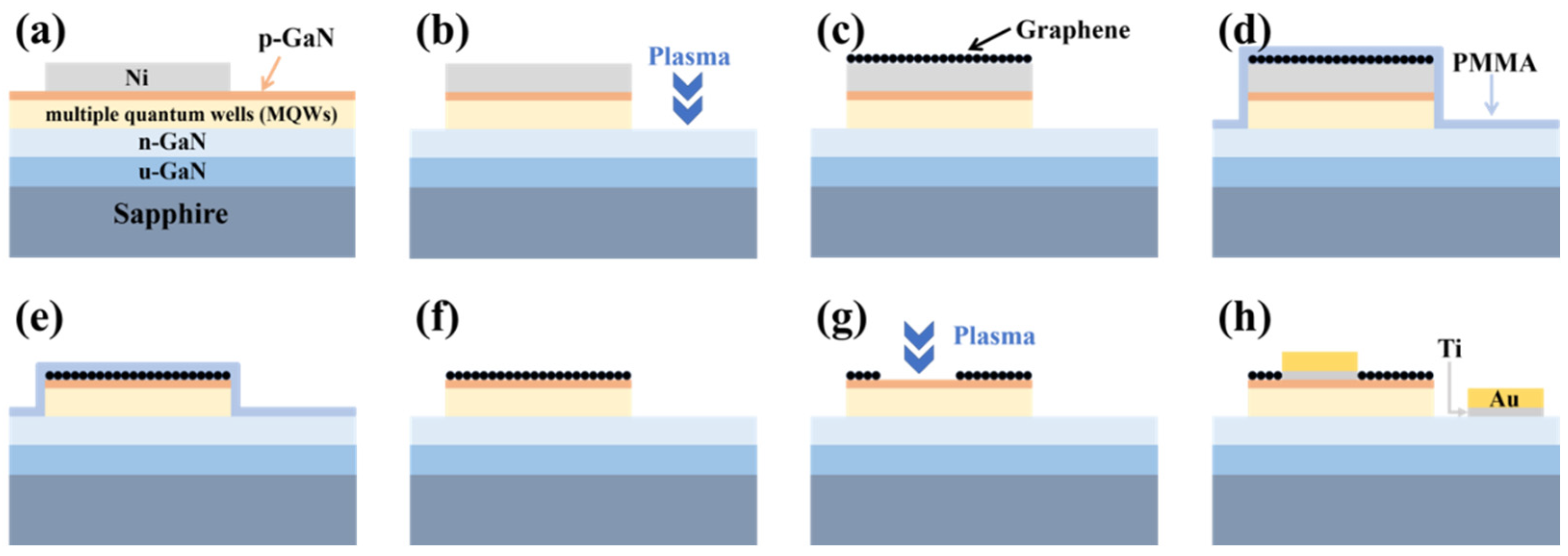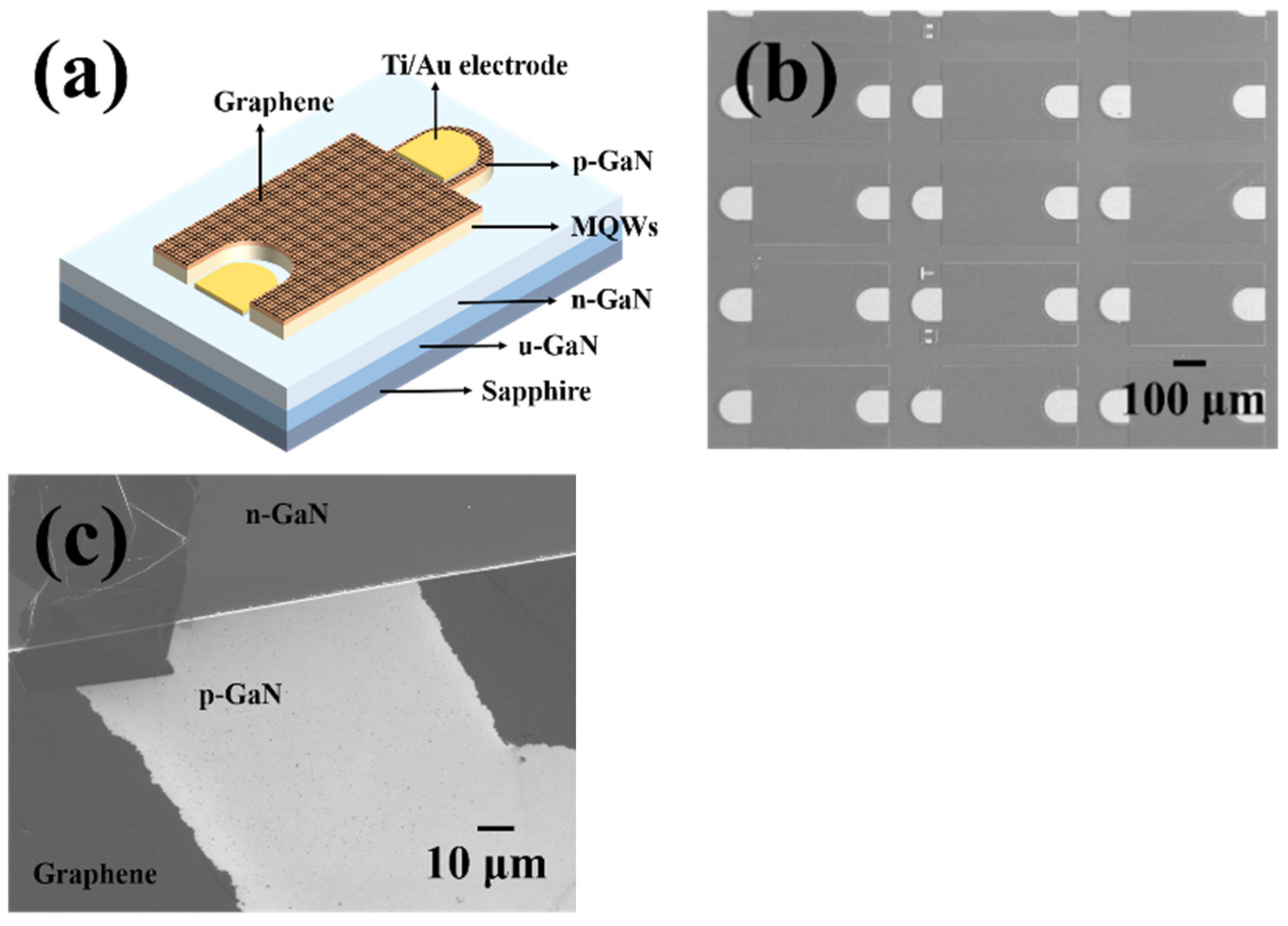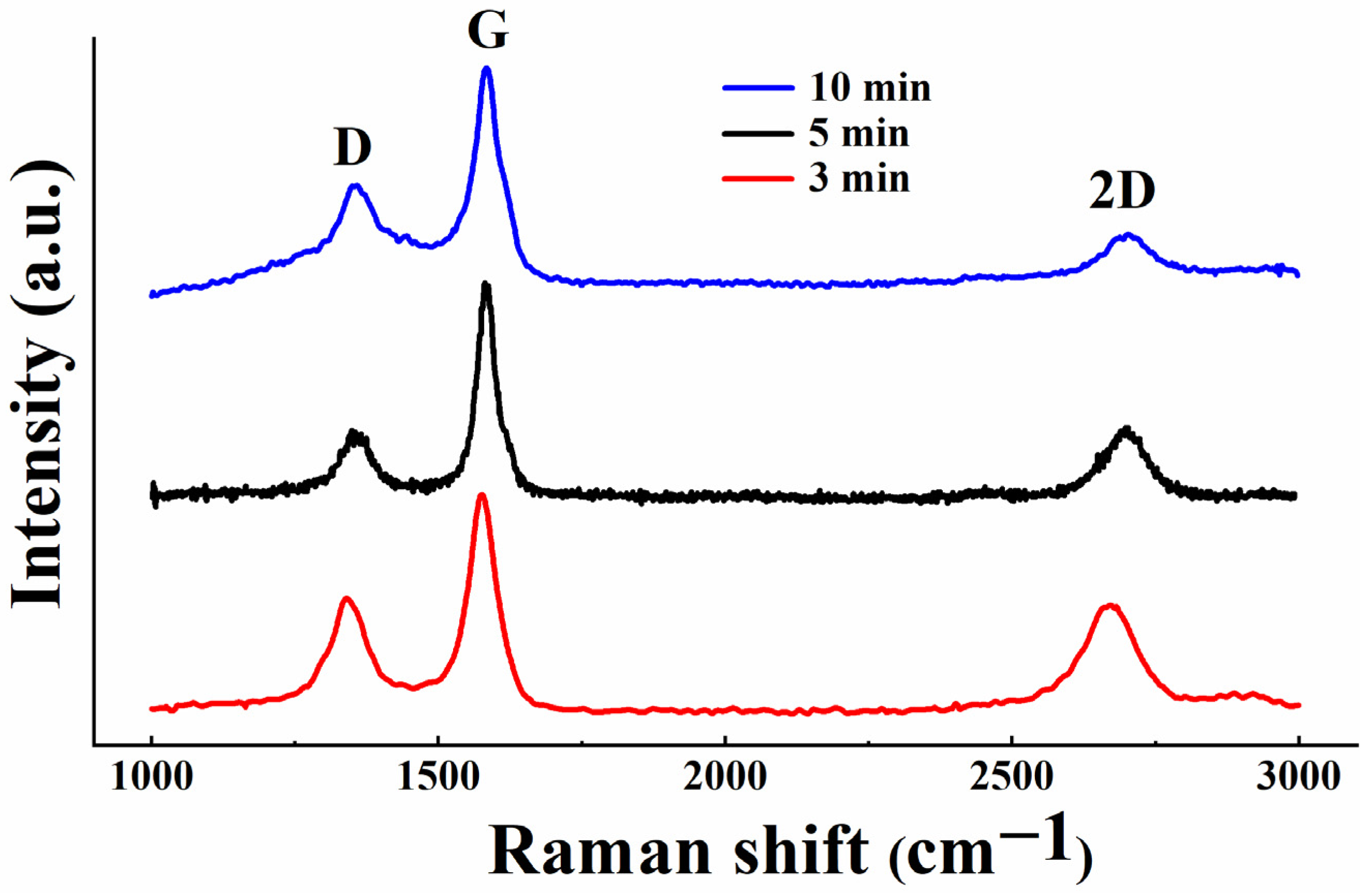Nickel-Assisted Transfer-Free Technology of Graphene Chemical Vapor Deposition on GaN for Improving the Electrical Performance of Light-Emitting Diodes
Abstract
:1. Introduction
2. Materials and Methods
3. Results and Discussion
4. Conclusions
Author Contributions
Funding
Data Availability Statement
Conflicts of Interest
References
- Amano, H.; Kito, M.; Hiramatsu, K.; Akasaki, I. P-type conduction in Mg-doped GaN treated with low-energy electron-beam irradiation (LEEBI). Jpn. J. Appl. Phys. 1989, 28, 2112–2114. [Google Scholar] [CrossRef] [Green Version]
- Nakamura, S.; Mukai, T.; Senoh, M.; Lwasa, N. Thermal annealing effects on p-type Mg-doped GaN films. Jpn. J. Appl. Phys. 1992, 31, 139–142. [Google Scholar] [CrossRef]
- Neugebauer, J.; Vandewalle, C.G. Role of hydrogen in doping of GaN. Appl. Phys. Lett. 1996, 68, 1829–1831. [Google Scholar] [CrossRef] [Green Version]
- Hamberg, I.; Granqvist, C.G. Evaporated Sn-doped In2O3 films: Basic optical properties and applications to energy-efficient windows. J. Appl. Phys. 1986, 60, 123–160. [Google Scholar] [CrossRef]
- Li, F.; Lin, Z.; Zhang, B.; Zhang, Y.; Wu, C.; Guo, T. Fabrication of flexible conductive graphene/Ag/Al-doped zinc oxide multilayer films for application in flexible organic light-emitting diodes. Org. Electron. 2013, 14, 2139–2143. [Google Scholar] [CrossRef]
- Jiang, G.; Tian, H.; Wang, X.-F.; Hirtz, T.; Wu, F.; Qiao, Y.-C.; Gou, G.-Y.; Wei, Y.-H.; Yang, J.-M.; Yang, S.; et al. An efficient flexible graphene-based light-emitting device. Nanoscale Adv. 2019, 1, 4745–4754. [Google Scholar] [CrossRef] [Green Version]
- Bolotin, K.; Sikes, K.; Jiang, Z.; Klima, M.; Fudenberg, G.; Hone, J.; Kim, P.; Stormer, H. Ultrahigh electron mobility in suspended graphene. Solid State Commun. 2008, 146, 351–355. [Google Scholar] [CrossRef] [Green Version]
- Li, X.; Cai, W.; Colombo, L.; Ruoff, R.S. Evolution of graphene growth on Ni and Cu by carbon isotope labeling. Nano Lett. 2009, 9, 4268–4272. [Google Scholar] [CrossRef] [PubMed] [Green Version]
- Sun, J.; Lindvall, N.; Cole, M.T.; Angel, K.T.T.; Wang, T.; Teo, K.B.K.; Chua, D.H.C.; Liu, J.; Yurgens, A. Low partial pressure chemical vapor deposition of graphene on copper. IEEE Trans. Nanotechnol. 2012, 11, 255–260. [Google Scholar] [CrossRef]
- Kim, B.-J.; Lee, C.; Jung, Y.; Baik, K.H.; Mastro, M.A.; Hite, J.K.; Eddy, C.R., Jr.; Kim, J. Large-area transparent conductive few-layer graphene electrode in GaN-based ultra-violet light-emitting diodes. Appl. Phys. Lett. 2011, 99, 143101. [Google Scholar] [CrossRef]
- Sutter, P.; Sadowski, J.T.; Sutter, E. Graphene on Pt (111): Growth and substrate interaction. Phys. Rev. B 2009, 80, 245411. [Google Scholar] [CrossRef] [Green Version]
- Xiong, F.; Sun, J.; Cole, M.T.; Guo, W.; Yan, C.; Dong, Y.; Wang, L.; Du, Z.; Feng, S.; Li, X.; et al. GaN LEDs with in situ synthesized transparent graphene heat-spreading electrodes fabricated by PECVD and penetration etching. J. Mater. Chem. C 2022, 10, 6794–6804. [Google Scholar] [CrossRef]
- Giannazzo, F.; Fisichella, G.; Greco, G.; La Magna, A.; Roccaforte, F.; Pecz, B.; Yakimova, R.; Dagher, R.; Michon, A.; Cordier, Y. Graphene integration with nitride semiconductors for high power and high frequency electronics. Phys. Status Solidi A 2017, 214, 1600460. [Google Scholar] [CrossRef]
- Ferrari, A.C.; Meyer, J.C.; Scardaci, V.; Casiraghi, C.; Lazzeri, M.; Mauri, F.; Piscanec, S.; Jiang, D.; Novoselov, K.S.; Roth, S.; et al. Raman spectrum of graphene and graphene layers. Phys. Rev. Lett. 2006, 97, 187401. [Google Scholar] [CrossRef] [PubMed] [Green Version]
- Bi, H.; Sun, S.; Huang, F.; Xie, X.; Jiang, M. Direct growth of few-layer graphene films on SiO2 substrates and their photovoltaic applications. J. Mater. Chem. 2012, 22, 411–416. [Google Scholar] [CrossRef]






Publisher’s Note: MDPI stays neutral with regard to jurisdictional claims in published maps and institutional affiliations. |
© 2022 by the authors. Licensee MDPI, Basel, Switzerland. This article is an open access article distributed under the terms and conditions of the Creative Commons Attribution (CC BY) license (https://creativecommons.org/licenses/by/4.0/).
Share and Cite
Tang, P.; Xiong, F.; Du, Z.; Li, K.; Mei, Y.; Guo, W.; Sun, J. Nickel-Assisted Transfer-Free Technology of Graphene Chemical Vapor Deposition on GaN for Improving the Electrical Performance of Light-Emitting Diodes. Crystals 2022, 12, 1497. https://doi.org/10.3390/cryst12101497
Tang P, Xiong F, Du Z, Li K, Mei Y, Guo W, Sun J. Nickel-Assisted Transfer-Free Technology of Graphene Chemical Vapor Deposition on GaN for Improving the Electrical Performance of Light-Emitting Diodes. Crystals. 2022; 12(10):1497. https://doi.org/10.3390/cryst12101497
Chicago/Turabian StyleTang, Penghao, Fangzhu Xiong, Zaifa Du, Kai Li, Yu Mei, Weiling Guo, and Jie Sun. 2022. "Nickel-Assisted Transfer-Free Technology of Graphene Chemical Vapor Deposition on GaN for Improving the Electrical Performance of Light-Emitting Diodes" Crystals 12, no. 10: 1497. https://doi.org/10.3390/cryst12101497
APA StyleTang, P., Xiong, F., Du, Z., Li, K., Mei, Y., Guo, W., & Sun, J. (2022). Nickel-Assisted Transfer-Free Technology of Graphene Chemical Vapor Deposition on GaN for Improving the Electrical Performance of Light-Emitting Diodes. Crystals, 12(10), 1497. https://doi.org/10.3390/cryst12101497






